

Spotlight Interview - Dr. Zahi Hawass
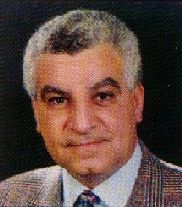
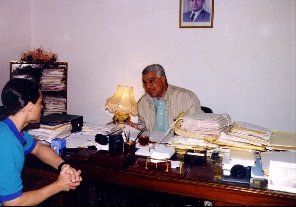
I met with Dr. Hawass on March 25, 1997 in his
office on the Giza Plateau. Here's what we discussed:
Guardian: Thank you for agreeing to meet with me Dr. Hawass. Today I want to
discuss the issues of the Great Pyramid and the Sphinx, and the recent controversies
concerning their true age and purpose. There's a lot of present day speculation by the New
Age proponents and their public that there may have been an advanced civilization prior to
the Egyptians. Has there been ANY physical evidence, whatsoever, that this is even
possible?
Dr. Hawass: Not a single piece of material culture - not a single object - has
been found at Giza that can be interpreted to come from a lost civilization. Instead we
find an abundance of tombs, bodies, ancient boats, hieroglyphic inscriptions, pottery,
bakeries and so on, from the Egyptian culture of the 4th Dynasty, about 2,500 BC. In
archaeology we have no evidence for an advanced civilization prior to 3,200 BC. Theories
and speculations about a lost civilization seem to excite people more than the discovery
of a culture that we actually find at Giza and elsewhere in Egypt, the culture of Egyptian
of whose existence we are certain. It was a great culture. Why do people need to look for
another? As scientists, we keep an open mind, but we have to base our ideas about the past
on archaeological evidence.
Guardian: Well, the lack of hard evidence is hard to ignore. But when one
actually does examine what evidence has already been uncovered, it all points to the
ancient Egyptians.
Dr. Hawass: I see that you agree on that! I want to add that if we found
evidence of a civilization at Giza older than that of the dynastic Egyptians, we would
not, and could not keep it from the public. But so far there has been no hard evidence to
support the theory of a prior civilization. Even if rain water eroded the Sphinx (which is
not very probable), it could not have washed away every single trace of an advanced
civilization!
Guardian: What do you think of the star alignment that indicate that the apices
of the pyramids align exactly with the belt in the constellation Orion in the year 10,500
BC? I am referring to the work of Robert Bauval and Adrian Gilbert entitled, The Orion
Mystery.
Dr. Hawass: I believe that in a more recent book by Robert Bauval and Graham
Hancock they claim that the match between the three pyramids, the stars in Orion's belt,
and between those stars and the Milky Way, and the pyramids and the Nile Valley, is best
for 10,500 BC. Bauval and Gilbert say that Abu Roash, Zawiyet el-Aryan, Abusir, and the
Dahshur pyramids of Sneferu complete the match of 4th Dynasty pyramids to the
constellations Orion and Taurus. Recently, this suggestion has been criticized by scholars
who have some competence in ancient astronomy. For example, Robert Cadwick, who has
studied ancient Assyrian, Babylonian, and Egyptian astronomy, points out in a recent KMT
article, that the supposed match leaves out some of their brightest stars in Orion. For
the convenience of their theory, Bauval and Gilbert match the 5th dynasty pyramids at
Abusir to stars, but not the other 5th or 6th dynasty pyramids. Chadwick points out that
if you actually superimpose the pattern of Orion onto the three Giza pyramids, the other
stars in the constellation do not match at all the pyramids of Abu Roash and Zawiyet
el-Aryan.
Guardian: I'm sure that you're aware that Robert Bauval and Graham Hancock are
publicly saying negative things about you and others who oversee the treasures of ancient
Egypt?
Dr. Hawass: Yes, it is unfortunate the things they are saying. For example,
Hancock and Bauval are asking people to sign petitions to stop secretive work at Giza. But
there is no secret work at Giza! Any research project is approved both by the Permanent
Committee of the Supreme Council for Antiquities (SCA) and by our Security Department. For
each project is appointed an inspector from the SCA Giza Inspectorate. At the conclusion
of fieldwork, both the inspector and the expedition director must submit a report to the
Inspectorate and to the offices of the SCA.
Of course, for Hancock and Bauval to suggest some kind of conspiracy at Giza helps them
sell books. Thus they profit from the pyramids while in Egypt we struggle to conserve
these treasures. While they turn out one profitable book after another about lost
civilizations and attack us for conspiring to conceal the truth, the truth is that we are
in an urgent struggle to save these world heritage monuments, and do not have time to deal
with all of their theories. We are certainly not helped by their attacks.
Guardian: They are of the opinion that Egyptian officials are blocking them and
others from returning to the Giza plateau to continue their research.
Dr. Hawass: So far, the research of Bauval and Hancock has required no research
permit - they are simply theorizing about astronomical alignments, ancient Egyptian
religious texts, and a lost civilization. No one is stopping Bauval and Hancock from
returning to Giza to speculate about such things.
However, as for the claim that I prevent some projects from working while allowing others,
I want to point out that Egyptian Law 117 of 1983 states that scholars and institutions
can work in the field of Egyptian archaeology, but we do not permit amateurs to carry out
field work. It is also the case that I alone do not approve work at Giza. I'm a member of
the Permanent Committee of forty scholars, revamped in recent weeks to twenty-two
scholars, that approves all applications for fieldwork. We consider applications from all
over the world. I do not make decisions alone.
Once a proposal is submitted under the authority of an appropriate institution, we must
consider whether the investigation will be detrimental to the site, and what the
consequences of the research will be our management of the site. After all, when foreign
expeditions come and go, we are left with the responsibility to manage and conserve what
they find. At Giza, we are also working hard to save the Sphinx. How can we give priority
to projects that want to look for secret tunnels and evidence of lost civilizations?
Guardian: What about the German discovery of a new door in the Queen's Chamber
air vent of the Great Pyramid? Why aren't they being allowed to continue their research
and open that door?
Dr. Hawass: Much of the comments about this have come from Mr.
Gantenbrink (a German robotics expert) and Mr. Bauval, who is a friend of Mr. Gantenbrink.
Mr. Gantenbrink was a member of a team of researchers under the recognized leadership of
the German Archaeological Institute in Cairo. The German Institute has the concession
[note: a concession is a permit to investigate a certain area], not Mr. Gantenbrink. As of
today, no application for further research has been submitted by the German Institute.
Apparently there is some difference of opinion between Mr. Gantenbrink and the German
Institute.
The discovery, by the way, is hardly a door in the usual sense. The so-called
"air-shaft" is smaller than 20 cm square. The robot-mounted camera came to a
blocking stone with two copper pins embedded in its face. This stopped further progress of
the robot. If this is a door, it is only big enough for a rat! The plug is many meters up
in the solid masonry of the pyramid, how should this so-called "door" be opened
without damaging the pyramid?
Guardian: Is it true that a Canadian research team is going to pick up where
the German researchers left off?
Dr. Hawass: As of today, we have received no proposal from Canadians to work in
the Khufu Pyramid.
Guardian: Some people allege that the Egyptian authorities and even
archaeologists are hiding things from the world because new discoveries refute the
existing archaeological theories. Is there any truth to this?
Dr. Hawass: This makes no sense. When we find something new at Giza, we
announce it to the world. The Sphinx and the Pyramids are world treasures. We are the
guardian's of these treasures, but they belong to the world. We will not hide any
discoveries, why would we? We have many reporters in Egypt, as you do in the United
States. We will tell the world community as soon as we have something to announce.
Guardian: Has there been anything new discovered recently?
Dr. Hawass: Yes, we just made a major discovery at the Third Pyramid of
Menkaure. We found a pair-statue of Ramesses II, about 15 feet tall, and weighing 4 tons
made of red granite:
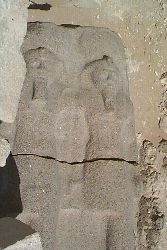
West of the Khufu pyramid we have found about 65 tombs. Some belonged to people with
titles connected to the pyramids. We found a beautifully decorated tomb of a man named
Kai:
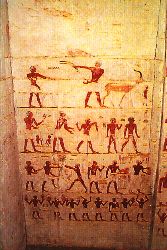
In front of the Khafre Valley Temple we found the entrance ramps, with tunnels running
underneath, mud brick walls and platforms, and other traces probably connected with the
Purification tent and Mortuary Workshop that the ancient texts indicated were connected
with the Royal Funeral in the Old Kingdom:

South of the Sphinx we found a cemetery of a working class with more titles connected to
the pyramids: "Overseer of the West Side", "Inspector of the East
Side", "Sculptor", and so on:
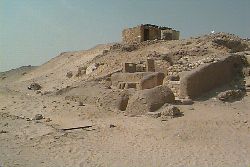
A major sewage project in the modern town along the Giza Plateau required digging hundreds
of meters of trenches, and carrying out scores of deep core drillings. This revealed
evidence of a large Old Kingdom settlement under the expansion of the modern town. By the
way, no evidence was found of a deeper, or older civilization.
Guardian: What about the supposed "new" doorway on the north side of
the Sphinx?
Dr. Hawass: The lower part of the Sphinx body is covered by layers of ancient
and modern repair masonry. In 1926, when he cleared the Sphinx, the French engineer Emile
Baraize found that a large patch of the ancient masonry cover had fallen away from the
bedrock body of the Sphinx on its north side. Several of his photographs show some kind of
recess behind the fallen masonry. Baraize recovered this area as part of his restorations
- so this has been seen already. It may be nothing more than a deep recess in the natural
rock of the Sphinx body. If we reopen the underlying masonry layers of this area, it will
be in the course of the ongoing restoration work, and not to look for secret tunnels.
Guardian: With the many restorations taking place in the Giza area, including
the Sphinx, I assume that preservation is a major priority of the Egyptian authorities?
Dr. Hawass: Yes. A major preservation program for Giza is being handled by the
Minister of Culture, Farouk Hosni. We have had the Second Pyramid of Khafre closed to the
public last year for almost a year to make minor repairs and to reduce the humidity
inside, it has since been reopened to the public. The Third Pyramid of Menkaure will be
closing in early April 1997 to give it a rest from thousands of tourists.
Guardian: Is the Giza Plateau in danger from any earthquakes??
Dr. Hawass: In 1990 an earthquake near Cairo opened a fissure in the Second
pyramid. We continue to study the plateau and the monuments for faults. But no earthquake
has centered on the plateau itself.
Guardian: As you know many people, particularly of the "New Age" ilk,
are very interested in finding what they call the "Hall of Records" , supposedly
(according to the psychic Edgar Cayce) located underneath the Sphinx. What do you think
about this search for such a Hall of Records?
Dr. Hawass: I do not believe in this "Hall of Records". The Sphinx
has been thoroughly excavated. My friend and colleague, Mark Lehner and I investigated it
ourselves in 1979. Nothing like a Hall of Records has been found in or near the Sphinx.
Guardian: There is also a prominent rumor about a secret passageway underneath
the Sphinx, could you comment on that as well?
Dr. Hawass: To date, there are only three known passages connected with the
Sphinx. Two of these might have actually been made by treasure hunters long after the
Sphinx was sculpted. In 1837 Howard Vyse created a crater just behind the head of the
Sphinx, and Mark Lehner and myself explored this again in 1979. We also located a passage
at the tail, under the restoration masonry. It is about 9 meters (27 feet) long and comes
to a dead end. A vertical shaft descends down through the Sphinx body from the top of the
waist. This is actually a widening of a large natural fissure that cuts through the entire
site of the Sphinx. Before modern restorations, it opened more than two meters wide across
the top of the back. Then there is the sealed recess on the north side of the Sphinx body
which we've already discussed, and we expect to open this soon, but I don't expect to find
anything in there.
Guardian: I've heard talk that the bedrock out of which the Sphinx was carved
ends a short distance in front of the Sphinx, giving rise to the idea that there is a
cliff or drop-off in front of the Sphinx.
Dr, Hawass: I believe that you are speaking of the harbor. Yes, we found
evidence of a drop-off out in front of the Sphinx Temple, and evidence of the harbor in
the tunnels under the approach ramps in front of the Khafre Valley Temple. But, as of yet,
no Hall of Records.
Guardian: Well, thank you for your time, I look forward to speaking with you
again later on this year. I'm sure that you'll do your best to keep exploring the plateau
and I look forward to seeing what else you come up with!
Dr. Hawass: Of course. Much of Egypt is still hidden beneath the sands.
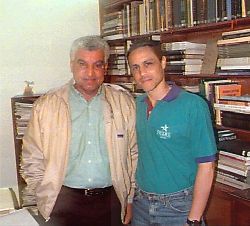
|
OTHER SPOTLIGHT INTERVIEWS |
Return to
Guardian's
CyberJourney To Egypt
 RETURN TO
Guardian's Egypt Main Gate
RETURN TO
Guardian's Egypt Main Gate
Guardian's CyberJourney To Egypt Copyright © 1997 Andrew Bayuk